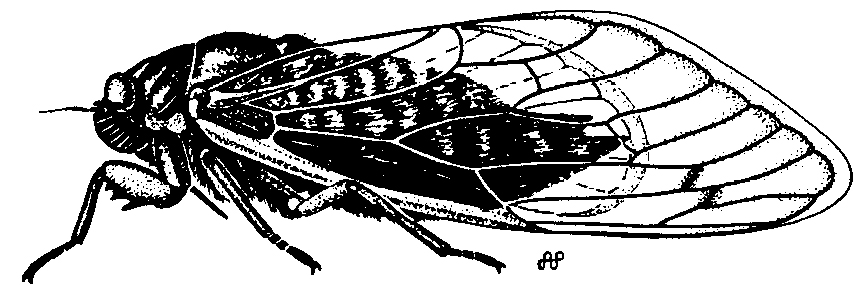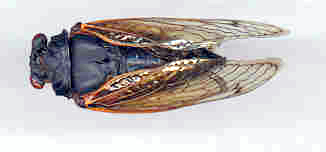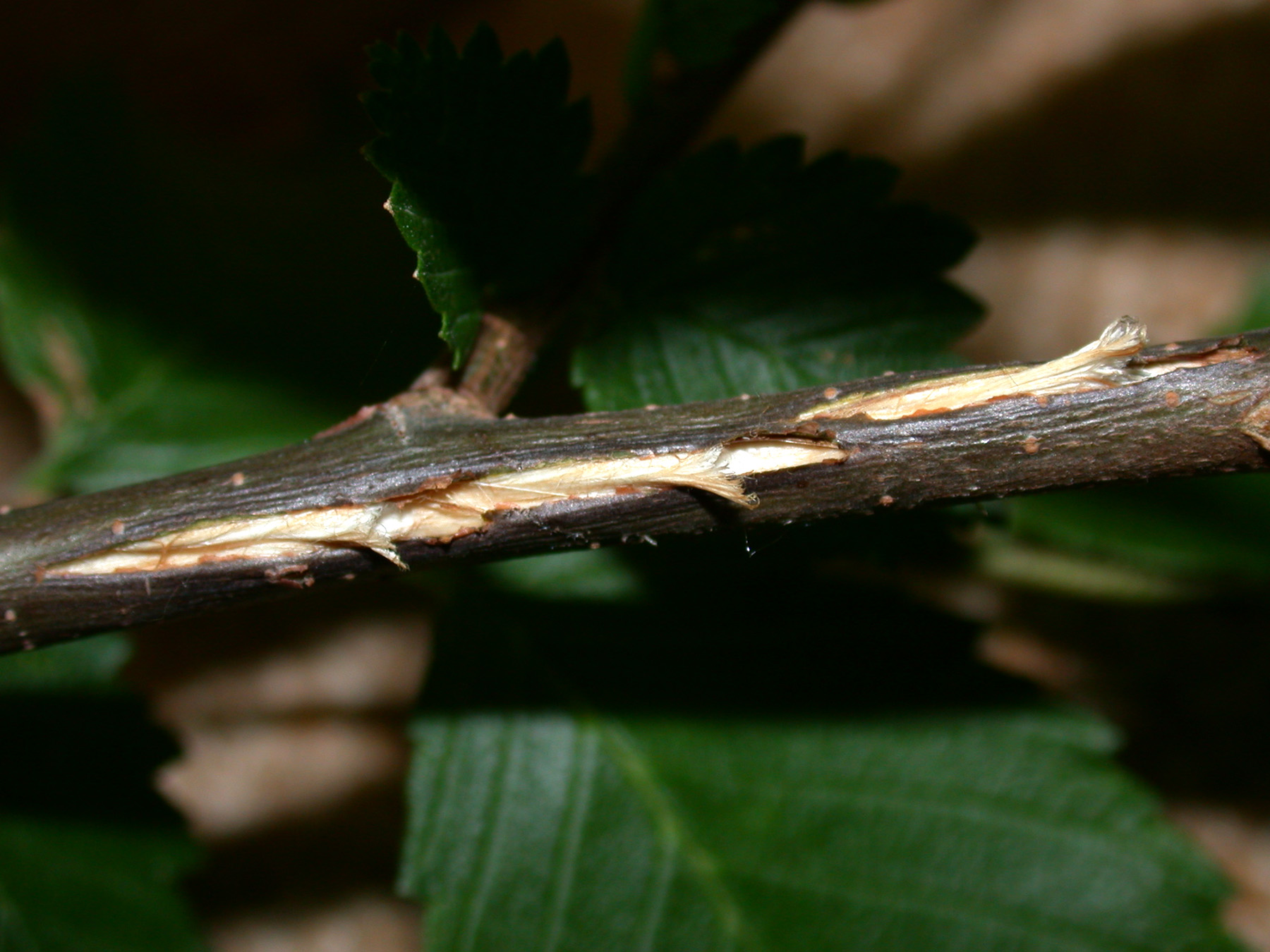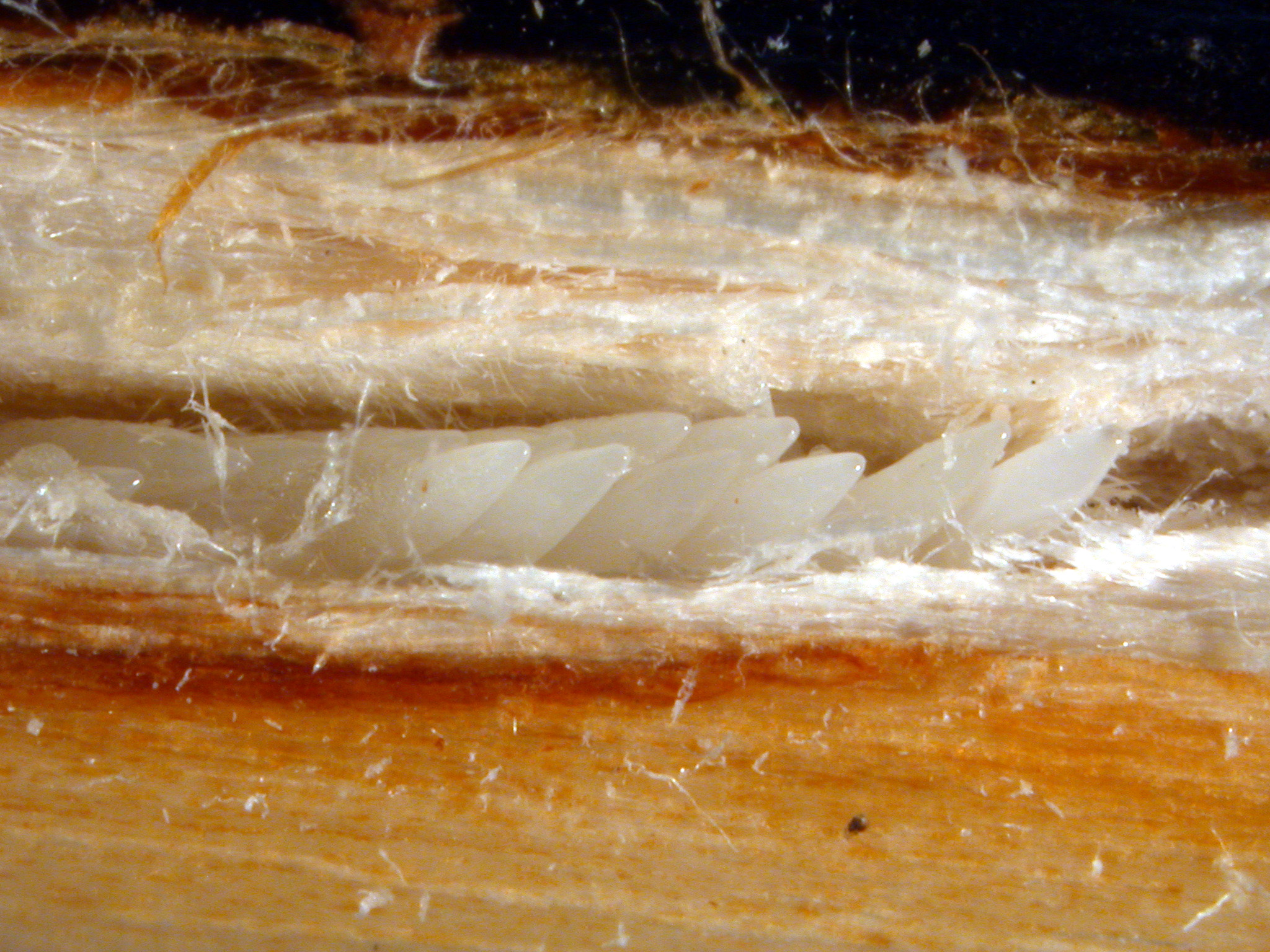Landscape & Ornamental
PERIODICAL CICADA IN INDIANA
Elizabeth Y. Long and Clifford S. Sadof, Extension Entomologists
If you want to view as pdf, click here
In Indiana most broods of the periodical cicada appear once every 17 years. However, two broods come out every 13 years. Periodical cicadas are usually referred to as “17-year or 13-year locusts.” They are about 1-1/2 to 2 inches long and have black bodies, reddish legs, wing margins, and eyes.
LIFE HISTORY
Cicadas have an interesting life cycle. They appear in the last part of May and during June. The incessant cadence of high-pitched, shrill sounds announces their presence. Only the males make this noise. It is produced by vibrating membranes on the underside of the first abdominal segment. The females have no sound-producing organs.
A female cicada has a knife-like organ that she uses to slit or puncture twigs of woody plants in which she lays her eggs. In about 6 weeks, the eggs hatch, and the nymphs drop to the ground, dig into the soil, and feed by sucking sap from tree roots.
Females will only lay eggs in twigs between 3/16” and 7/16” in diameter. At the end of 13 or 17 years, depending upon the brood, the nymphs come out of the ground. They crawl up tree trunks, posts, or other objects, shed their last shell, and emerge as winged cicadas. These adults live for about one month. During this time they mate, and each female lays 400-600 eggs. Cicadas are abundant only in areas where trees harbored the eggs of the previous generation. Cicadas can be very numerous in some areas and absent in woodlots nearby.
DAMAGE TO TREES AND SHRUBS
While some people consider the mass emergence of cicadas one of nature’s many wonders, others find it a nuisance. In urban areas, heavy infestations can make the sidewalks and roads slick with dead insect carcasses. In fruit orchards and nurseries, cicadas can seriously damage young trees whose main stems and branches are between 3/16” and 7/16” diameter.
Female cicadas cause damage when they puncture or slit the twigs of trees and shrubs to lay their eggs. Infested branches appear as if the eggs have been “stitched” in by a sewing machine. These branches will turn brown, die, and sometimes break off. Female cicadas have been reported to lay eggs on over 200 woody tree species and are common on oak, hickory, flowering fruit trees, mountain ash, and grape vines.
CONTROLLING ADULT CICADAS
Cultural Control
The first step in managing cicadas is to familiarize yourself with their expected emergence periods. These are listed in Table 1. In this way, you can avoid damage by good planning.
When possible, avoid planting new trees in the fall before or during the spring that cicadas will emerge. This could be especially helpful in fruit orchards or woody plant nurseries. Also, delay pruning until the cicadas have disappeared. The injured branches can then be removed after cicadas have stopped flying.
Small ornamental trees and shrubs (<10’ tall) can be protected by covering them with no larger than 1/2” mesh screening while cicadas are present. In most cases, with the exception of densely planted orchards or nurseries, netting is more cost effective than spraying insecticides.
Biological Control
There are many natural enemies of cicadas. Birds, and squirrels will feast on cicadas during a mass emergence. However, the large number of cicadas are likely to outstrip the capacity of these animals to control them.
Chemical Control
The use of pesticides for controlling periodical cicadas is controversial. Pesticide trials indicate that pesticide applications need to be repeated every 3-4 days to prevent oviposition. This is not practical for the 6-week flight period. Cultural controls are therefore recommended.
Those who still wish to use pesticides to reduce injury should apply them to foliage and trunks every 7-10 days during the 6-week flight period.
Several insecticides can be used by homeowners to protect ornamental shrubs and fruit tees. Their active ingredients (commonly available product names) are as follows:
• Zeta-cypermethrin (GardenTech Sevin)
• Gamma-cyhalothrin (Spectracide Triazicide for
Lawns and Landscapes Concentrate)
• Permethrin (Bonide Eight)
Commercial fruit producers wanting to protect their fruit trees can use pyrethroids like esfenvalerate (Asana XL) or cyfluthrin (Baythroid XL) in accordance with the label. Note that labeled insecticides will kill beneficial insects and likely result in a spider mite problem that will need to be managed for the rest of the season.
Periodical cicadas -- Magicicada spp. (There are six known species, five of which have been reported in Indiana.)
(Photo credit: Arwin Provonsha, Dept. of Entomology, Purdue Univ.)
| Table 1. When and where in Indiana the 17-year and 13-year cicadas will appear. |
|---|
| Brood Number | Race | Year to Appear | Where They Will Appear |
|---|---|---|---|
| VI | 17-year | 2034 | Reported in all Indiana counties in 2017, but may be a "shadow brood" of brood X |
| X | 17-year | 2021 | In all counties, but heaviest in south-central Indiana; largest of the 17-year broods |
| XII | 17-year | 2023 | Allen and Orange counties; scarce in Indiana |
| XIII | 17-year | 2024 | Lake, LaPorte, and Porter counties |
| XIV | 17-year | 2025 | 40 counties, but heaviest in southwestern Indiana; dense swarms expected in Brown and Warrick |
| XIX | 13-year | 2024 | 8 western counties, from Posey and Warrick on the south to Newton and Jasper on the north |
| XXIII | 13-year | 2028 | Several counties in southwestern Indiana, with Vigo county being the northern limit |
Adult periodical cicada (side view)
(Photo credit: Gary Michel)
Adult periodical cicada (side view)
(Photo credit: Gary Michel)
| Table 2. Plants at high risk for damage by cicadaS . |
|---|
| Genus | Common Name |
|---|---|
| Acer | Maples |
| Amelanchier | Serviceberry |
| Castanea | Chestnut |
| Apple, Crabapple | Katsura tree |
| Cercis | Redbud |
| Chionanthus | Fringe tree |
| Cornus | Dogwood |
| Cotinus | Cotinus |
| Cotoneaster | Cotoneaster |
| Crataegus | Hawthorn, Cockspur |
| Fraxinus | Ash |
| Hamamelis | Witch-hazel |
| Malus | Apple, Crabapple |
| Nyssa | Sour gum |
| Ostrya | Hophornbeam |
| Oxydendrum | Sourwood |
| Prunus | Cherries, Peaches & Plums |
| Quercus | Oaks |
| Rosa | Roses |
| Sorbus | Mountain Ash |
| Tilia | Basswood |
| Ulmus | Elmwood |
| Weigela | Weigela |
| Table 3. Plants with moderate and low susceptibility to cicada damage |
|---|
| Genus | Common Name |
|---|---|
| Iiex | Hollies |
| Ladumum | Golden chain tree |
| Phellodendron | Corktree |
| Betula | Birch |
| Carpinus | Hornbeam |
| Magnolia | Magnolia |
| Chamaecyparis | Cedar |
Web Links For More Information
Raupp, M. J. 2021. Return of the Periodical Cicadas in 2021: Biology, Plant Injury and Management
Cicada Mania. http://www.cicadamania.com
Periodical Cicada Emergence In Tippecanoe County, Indiana in 2004. https://youtu.be/f_vWhsZgFdU
Adult periodical cicadas
(Photo credit: J. Obermeyer
Periodical cicada damage to stems
(Photo credit: J. Obermeyer)
Periodical cicada eggs in stems
(Photo credit: J. Obermeyer
Dieback on oak trees caused by cicada egg laying
(Photo credit: J. Obermeyer)
READ AND FOLLOW ALL LABEL INSTRUCTIONS. THIS INCLUDES DIRECTIONS FOR USE, PRECAUTIONARY STATEMENTS (HAZARDS TO HUMANS, DOMESTIC ANIMALS, AND ENDANGERED SPECIES), ENVIRONMENTAL HAZARDS, RATES OF APPLICATION, NUMBER OF APPLICATIONS, REENTRY INTERVALS, HARVEST RESTRICTIONS, STORAGE AND DISPOSAL, AND ANY SPECIFIC WARNINGS AND/OR PRECAUTIONS FOR SAFE HANDLING OF THE PESTICIDE.
April 2024

It is the policy of the Purdue University Cooperative Extension Service that all persons have equal opportunity and access to its educational programs, services, activities, and facilities without regard to race, religion, color, sex, age, national origin or ancestry, marital status, parental status, sexual orientation, disability or status as a veteran. Purdue University is an Affirmative Action institution. This material may be available in alternative formats.
This work is supported in part by Extension Implementation Grant 2017-70006-27140/ IND011460G4-1013877 from the USDA National Institute of Food and Agriculture.
1-888-EXT-INFO
www.extension.purdue.edu
Order or download materials from www.the-education-store.com









